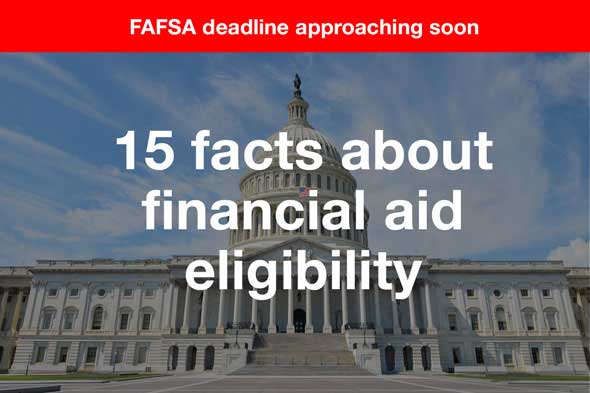{{parent.cta_data.text}}
COMMUNITY

15 facts about financial aid eligibility
http://www.savingforcollege.com/articles/15-freaky-facts-about-financial-aid-eligibility-686
Updated: 2015-03-11
Deadlines for submitting the Free Application for Federal Student Aid (FAFSA) are quickly approaching. Each year, over $150 billion in federal student aid is awarded to more than 15 million students who want help paying for college. Yet the financial aid system is so complicated that many families end up making costly mistakes on their applications. Here are 15 facts that can help you maximize your eligibility and reduce the amount you'll have to pay for college out of pocket.


2. Financial aid eligibility is recalculated annually
- Your Expected Family Contribution (EFC) is calculated using information from your FAFSA, which needs to be completed for each school year.
- Your school will use your EFC to determine how much federal student aid you receive.
- Any significant changes in your household assets could cause the amount of aid you receive to vary from the previous year.

3. You need to maintain good grades for all types of aid
- Those who qualify for need-based aid must remain in good academic standing to renew their financial aid in subsequent years.
- Don’t think of your financial aid application as a “one-and-done” activity.
- Your school’s financial aid office will determine if you are meeting their satisfactory academic progress policy to stay eligible.

4. If you’re a parent who is close to retirement, you might want to consider holding off for a few more years
- Any liquid assets will be counted against your EFC, even those intended for a parent’s retirement.
- This includes the sale of a home, inheritance and even company retirement perks such as vested stock options.
- It’s unlikely that you would be able to verbally convince a financial aid officer otherwise.

5. Private colleges sometimes offer more financial aid than public schools
- Don’t cross a private college off your list simply because of its price tag.
- There are many private colleges that offer need-based and merit-based aid packages.
- Some students actually end up paying a lower total price at a private school, even though the initial sticker price is much higher.

6. If you’re applying for financial aid, you may be better off saving with a 529 plan than a UGMA/UTMA account
- Funds saved in a UGMA/UTMA custodial account are considered a student’s assets and are assessed at 20% when determining your family’s EFC.
- Savings in a 529 account, however, are considered parental assets and are assessed at a maximum rate of only 5.64%.
- That means if you saved $10,000 your EFC could increase by $2,000 or $564, depending on which vehicle you used to save.

7. A student needs to be enrolled in at least 6 credit hours per semester to qualify for federal loans
- Keep in mind, however, that you can still take out the same dollar amount in unsubsidized Stafford Loans whether you are a full-time or part-time student.
- If you are taking a reduced course load, it’s recommended that you reduce the amount you borrow proportionately to avoid racking up too much debt.
- There is also a limit to how much a student can borrow and it is possible to run out before graduation.

8. Federal grants are prorated based on enrollment status
- Grants are typically need-based awards that do not have to be paid back.
- Students who are enrolled half-time will receive half of the award that would have been given if they were a full-time student.
- Students who receive grants may want to think carefully before reducing their credit hours since they will miss out on the funding.

9. Parents who remarry are no longer considered to have a “single” income
- Single parents who are recently engaged may want to delay their wedding plans until after their child completes their last financial aid application.
- The Higher Education Act of 1965 requires remarried parents to include the new spouse’s income on the FAFSA.
- The College Scholarship Service (CSS/Financial Aid Profile), used by some private schools may require you to report income of up to four people if the original parents are divorced and both remarry.

10. Grandparent-owned 529 plans can negatively affect financial aid eligibility
- Assets in a grandparent-owned plan will count as student income on the following year’s FAFSA when used to pay for college.
- Student income is assessed at 50% when calculating your EFC.
- Grandparents are generally advised to use the funds to pay for the student’s last year of college, when they know they won’t be filing another FAFSA.

11. Colleges view vacation home equity as a liquid asset
- Perhaps you’ve been considering purchasing a vacation home now that the kids have almost left the nest for good.
- Before you put a downpayment on a lakehouse, know that equity in a vacation home is considered a liquid asset both on the FAFSA and the CSS/Financial Aid Profile.
- Equity in your family home, however, does not count as an asset on the FAFSA, but is counted on the CSS/Financial Aid Profile.

12. Students sometimes have a chance to appeal their case to a financial aid office
- Sometimes eligibility can be reduced because of something beyond the student’s control.
- For example, if a relative dies and leaves inheritance money it will most likely be counted as an asset.
- In unusual circumstances like this, the student may request their situation to be reevaluated through a process called professional judgment.

13. Students from wealthy families may still qualify for aid
- Financial aid eligibility is not solely based on income.
- Other factors include the number of other family members attending college and household medical expenses.
- With the help of a financial professional, high income families can also adjust their household financials to maximize eligibility.

14. Know what you are signing up for as an early decision applicant
- When a student accepts an early decision agreement in the fall, it includes the school’s financial aid offer.
- This is a binding agreement, which means they won’t be able to shop around or take a better offer from another school.
- Despite popular belief, applying early does not always mean you have a better chance for acceptance.

15. Fill out the FAFSA even if you don’t want loans
- When you fill out the FAFSA, you are applying for federal and state funds, as well as awards from your school.
- These can include grants and scholarships in addition to federal loans.
- Financial aid is first come, first serve, so file early!
Deadlines for submitting the Free Application for Federal Student Aid (FAFSA) are quickly approaching. Each year, over $150 billion in federal student aid is awarded to more than 15 million students who want help paying for college. Yet the financial aid system is so complicated that many families end up making costly mistakes on their applications. Here are 15 facts that can help you maximize your eligibility and reduce the amount you'll have to pay for college out of pocket.


1. Around 38% of financial aid awarded is in the form of federal loans
- Too many families assume that any type of “award” is free money.
- There are generally three types of awards: grants, scholarships and loans.
- Student loans need to be paid back and you will have to pay interest.

2. Financial aid eligibility is recalculated annually
- Your Expected Family Contribution (EFC) is calculated using information from your FAFSA, which needs to be completed for each school year.
- Your school will use your EFC to determine how much federal student aid you receive.
- Any significant changes in your household assets could cause the amount of aid you receive to vary from the previous year.

3. You need to maintain good grades for all types of aid
- Those who qualify for need-based aid must remain in good academic standing to renew their financial aid in subsequent years.
- Don’t think of your financial aid application as a “one-and-done” activity.
- Your school’s financial aid office will determine if you are meeting their satisfactory academic progress policy to stay eligible.

4. If you’re a parent who is close to retirement, you might want to consider holding off for a few more years
- Any liquid assets will be counted against your EFC, even those intended for a parent’s retirement.
- This includes the sale of a home, inheritance and even company retirement perks such as vested stock options.
- It’s unlikely that you would be able to verbally convince a financial aid officer otherwise.

5. Private colleges sometimes offer more financial aid than public schools
- Don’t cross a private college off your list simply because of its price tag.
- There are many private colleges that offer need-based and merit-based aid packages.
- Some students actually end up paying a lower total price at a private school, even though the initial sticker price is much higher.

6. If you’re applying for financial aid, you may be better off saving with a 529 plan than a UGMA/UTMA account
- Funds saved in a UGMA/UTMA custodial account are considered a student’s assets and are assessed at 20% when determining your family’s EFC.
- Savings in a 529 account, however, are considered parental assets and are assessed at a maximum rate of only 5.64%.
- That means if you saved $10,000 your EFC could increase by $2,000 or $564, depending on which vehicle you used to save.

7. A student needs to be enrolled in at least 6 credit hours per semester to qualify for federal loans
- Keep in mind, however, that you can still take out the same dollar amount in unsubsidized Stafford Loans whether you are a full-time or part-time student.
- If you are taking a reduced course load, it’s recommended that you reduce the amount you borrow proportionately to avoid racking up too much debt.
- There is also a limit to how much a student can borrow and it is possible to run out before graduation.

8. Federal grants are prorated based on enrollment status
- Grants are typically need-based awards that do not have to be paid back.
- Students who are enrolled half-time will receive half of the award that would have been given if they were a full-time student.
- Students who receive grants may want to think carefully before reducing their credit hours since they will miss out on the funding.

9. Parents who remarry are no longer considered to have a “single” income
- Single parents who are recently engaged may want to delay their wedding plans until after their child completes their last financial aid application.
- The Higher Education Act of 1965 requires remarried parents to include the new spouse’s income on the FAFSA.
- The College Scholarship Service (CSS/Financial Aid Profile), used by some private schools may require you to report income of up to four people if the original parents are divorced and both remarry.

10. Grandparent-owned 529 plans can negatively affect financial aid eligibility
- Assets in a grandparent-owned plan will count as student income on the following year’s FAFSA when used to pay for college.
- Student income is assessed at 50% when calculating your EFC.
- Grandparents are generally advised to use the funds to pay for the student’s last year of college, when they know they won’t be filing another FAFSA.

11. Colleges view vacation home equity as a liquid asset
- Perhaps you’ve been considering purchasing a vacation home now that the kids have almost left the nest for good.
- Before you put a downpayment on a lakehouse, know that equity in a vacation home is considered a liquid asset both on the FAFSA and the CSS/Financial Aid Profile.
- Equity in your family home, however, does not count as an asset on the FAFSA, but is counted on the CSS/Financial Aid Profile.

12. Students sometimes have a chance to appeal their case to a financial aid office
- Sometimes eligibility can be reduced because of something beyond the student’s control.
- For example, if a relative dies and leaves inheritance money it will most likely be counted as an asset.
- In unusual circumstances like this, the student may request their situation to be reevaluated through a process called professional judgment.

13. Students from wealthy families may still qualify for aid
- Financial aid eligibility is not solely based on income.
- Other factors include the number of other family members attending college and household medical expenses.
- With the help of a financial professional, high income families can also adjust their household financials to maximize eligibility.

14. Know what you are signing up for as an early decision applicant
- When a student accepts an early decision agreement in the fall, it includes the school’s financial aid offer.
- This is a binding agreement, which means they won’t be able to shop around or take a better offer from another school.
- Despite popular belief, applying early does not always mean you have a better chance for acceptance.

15. Fill out the FAFSA even if you don’t want loans
- When you fill out the FAFSA, you are applying for federal and state funds, as well as awards from your school.
- These can include grants and scholarships in addition to federal loans.
- Financial aid is first come, first serve, so file early!
If you liked this post and think it would help others save for college, please share!
Recommended Articles
SPONSOR CONTENT
Financial Professionals
Top 529 College Savings Plans
One-year rankings are based on a plan's average investment returns over the last 12 months.
| State | Plan Name | |
|---|---|---|
| 1 | Nevada | USAA 529 Education Savings Plan |
| 2 | Florida | Florida 529 Savings Plan |
| 3 | New Jersey | NJBEST 529 College Savings Plan |
Three-year rankings are based on a plan's average annual investment returns over the last three years.
| State | Plan Name | |
|---|---|---|
| 1 | South Dakota | CollegeAccess 529 (Direct-sold) |
| 2 | Wisconsin | Edvest 529 |
| 3 | Nevada | USAA 529 Education Savings Plan |
Five-year rankings are based on a plan's average annual investment returns over the last five years
| State | Plan Name | |
|---|---|---|
| 1 | Indiana | CollegeChoice 529 Direct Savings Plan |
| 2 | Florida | Florida 529 Savings Plan |
| 3 | Alaska | T. Rowe Price College Savings Plan |
10-year rankings are based on a plan's average annual investment returns over the last ten years.
| State | Plan Name | |
|---|---|---|
| 1 | West Virginia | SMART529 WV Direct College Savings Plan |
| 2 | South Carolina | Future Scholar 529 College Savings Plan (Direct-sold) |
| 3 | Ohio | Ohio's 529 Plan, CollegeAdvantage |

 {{parent.title}}
{{parent.title}}
 Login
Login

